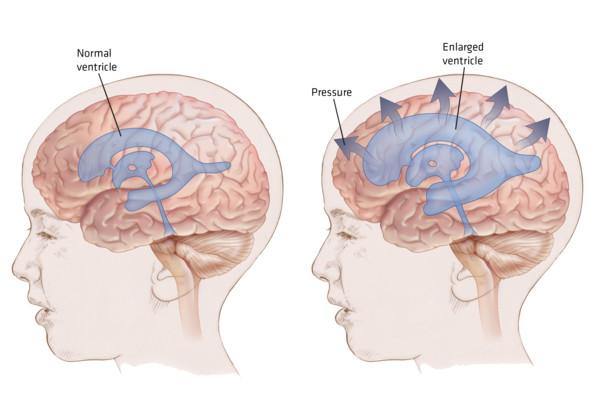ABOUT THE DISEASE
Hydrocephalus is a condition which causes excessive accumulation of fluid in the brain. This fluid is cerebrospinal fluid (CSF) - a clear fluid surrounding the brain and spinal cord. The CSF normally flows through narrow pathways from one ventricle to the next, then over the outside of the brain and down the spinal cord. The CSF is absorbed into the bloodstream and re-circulates. When its pathway is blocked, the excessive accumulation of CSF results in an abnormal dilation of the spaces in the brain called ventricles causing potentially harmful pressure on the tissues of the brain in the case of adults. In small babies when the skull bones have not fused together, the head will grow larger. If the pressure of the fluid is normal, it is termed as Normal Pressure Hydrocephalus (NPH), usually seen in older adults.

SYMPTOMS
In infants with hydrocephalus, other than the bulge making the head to be larger than expected, early symptoms may also include:
- • Downward deviation of the eyes
- • Irritability
- • Seizures
- • Sleepiness
- • Vomiting
Symptoms that may occur in older children can include:
- • Learning difficulties such as problems with concentration, reasoning and short-term memory.
- • Changes in facial appearance and eye spacing
- • Visual difficulties - Crossed eyes or uncontrolled eye movements
- • Difficulty feeding
- • Excessive sleepiness
- • Headache
- • Irritability, poor temper control
- • Loss of bladder control
- • Problems with coordination and trouble walking
- • Muscle spasticity (spasm)
- • Vomiting
CAUSES
Hydrocephalus can be present at birth (congenital) due to genetic abnormalities such as spina bifida (birth defect of the spine) or in the case of premature babies who get clots due to fluctuation in blood pressure.
Some of the causes for this developing in adults are as follows:
- Bleeding in the brain (hemorrhage), as a result of stroke or trauma.
- An infection of the membranes covering the brain called meningitis. The inflammation and debris from this infection can block the drainage pathways. Meningitis may occur at any age. It is more common in children.
- A particular group of disorders involving the formation of fluid-filled cysts in the CSF system (for example Dandy Walker cysts). In these cases, hydrocephalus is often due to pressure on the surrounding tissues by the enlarging cyst.
- Tumors of the brain cause compression and swelling of surrounding tissues. This can result in poor drainage of CSF.
DIAGNOSIS
- Physical examination
- Head CT scan or MRI
TREATMENT METHODS
If possible, surgery is done to remove the blockage.
Alternatively, Hydrocephalus is treated with the surgical placement of a shunt system. This system diverts the flow of CSF from a site within the central nervous system to another area of the body where it can be absorbed as part of the circulatory process. It can be Ventriculo-peritoneal shunt (VP Shunt), Ventriculo-atrial shunt or Ventriculo-pleural shunt. In a few cases it can be treated with an alternative procedure called Endoscopic third ventriculostomy (ETV). In this procedure, a small hole is made in the floor of the third ventricle, allowing the CSF to bypass the obstruction and flow toward the site of resorption around the surface of the brain. This avoids the need for a shunt.
You may also like to learn about:
Brain tumor
Meningitis
Stroke
Spina bifida
Spinal stenosis
Brain haemorrhage